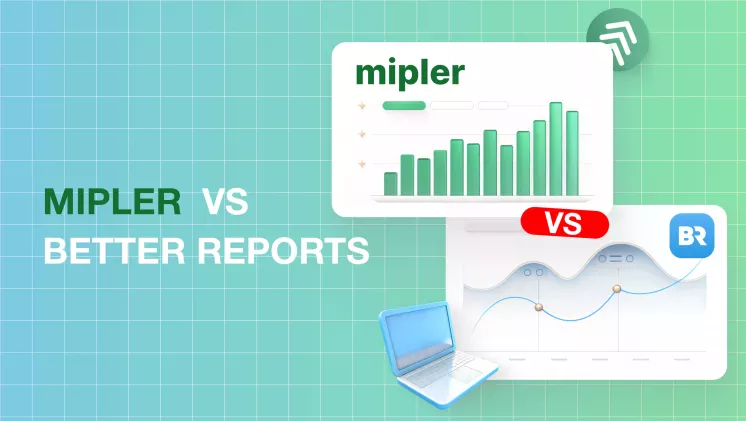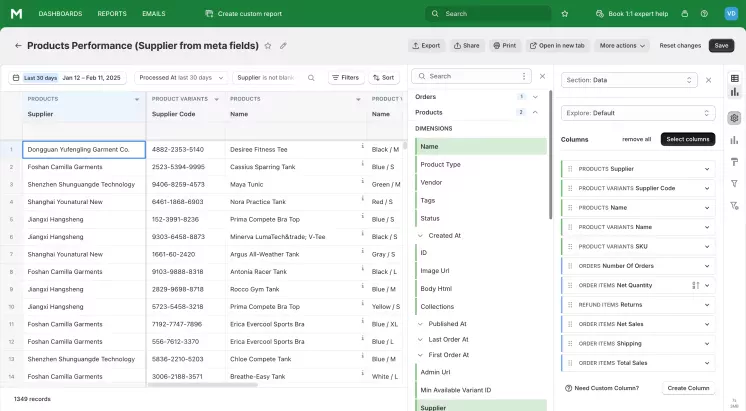
Reports Mipler vs Better Reports
Raw data is not enough when it comes to getting insights about the performance of your Shopify store. Mipler and Better Reports are two of the most popular reporting tools that Shopify merchants can use. They both have strong sales, inventory, and customer behavior analysis capabilities, but are very different in ease of use, customization, and philosophy.
This guide will compare the essentials of Mipler and Better Reports, such as their performance, integrations, price, and ease of use, to assist you in selecting the one that suits your business. If you need fast, real-time reports or hundreds of prebuilt templates, you will undoubtedly find a clear winner in your case.
What Are Reports Mipler and Better Reports
Mipler is a flexible, fully customizable Shopify reporting platform. It lets merchants build, save, and share custom dashboards and reports across one or multiple stores. Mipler covers the same data domains - sales trends, inventory levels, customer behavior, etc. but emphasizes simplicity. Its intuitive interface and advanced filters mean even non-technical users can create detailed reports in minutes.
Better Reports is a Shopify analytics app that extracts and visualizes store data which offers over 100 built-in reports (for sales, payments, inventory, customers, payouts, etc.) plus a drag-and-drop report builder for custom analyses. It integrates with Shopify POS, supports multiple stores and currencies, and can email or export reports automatically (PDF/Excel/Google Sheets).
Pros and Cons

- Performance: Mipler advanced analytics provides quick and confident reporting to enhance stores performance. Better Reports can deal with complex queries, however Mipler can be much lighter and faster to use on a routine basis.
- Customization: Mipler is a flexible custom reporting that has various export formats. Extensive customization is also available in Better Reports, but Mipler is usually easier to understand.
- Integrations: Mipler integrates with key tools like Google Sheets for easy data sharing. Better Reports has more variety (Drive, Stripe, POS), but Mipler is more basic in terms of what is needed.
- Usability: Mipler is a clean interface and simple in report generation. Better Reports is also easy to use, however, it has a larger learning curve due to BRQL, which should be learned to use Better Reports more efficiently, whereas Mipler has a simpler design and may be learned faster.
- Customer Support: Support team at Mipler is quick, friendly, efficient and provides you with a dedicated support at higher plans. Better Reports only had support team that can assist you during working hours.
Product Comparison Table
| Category | Mipler | Better Reports |
|---|---|---|
| Custom Reports | Drag-and-drop report builder with custom columns, filters, and formulas (With user-friendly documentation) and 120+ built-in templates. |
Visual builder with pivot tables and charts, but relies on BRQL for custom metrics and offers fewer templates (~100). |
| Performance and Scalability |
Unlimited orders on any account tier. Built-in support for multi-store dashboards and API access for advanced automation. |
Scales for large merchants with multi-currency/store support, but lacks built-in API access and has limits on lower-tier plans. |
| Metafields, Tags Formulas |
Full support of Shopify metafields, tags, and order notes in reports. Create custom fields and formulas using Mipler’s built-in calculation engine. |
Have access to all Shopify data and support custom fields with BRQL, but requires query language knowledge, making it less intuitive. |
| Real-time Scheduled Reports |
Real-time reports inside Shopify admin, automated email delivery, Google Sheets sync, and public report links for collaboration. |
Scheduled reports to email or Google Sheets, but no real-time sync or instant report generation, limited to data refresh intervals. |
| Dashboards Charts |
Interactive dashboards with cross-filters and global filters, supports many chart types (bar, line, scatter, etc.) and pivot tables. |
Offers custom dashboards and charts, but focuses more on static report building than interactive exploration. |
| UI & Ease of Use | Clean, modern, easy-to-use UI. Drag-and-drop logic makes it ideal for non-technical users. Backed by expert onboarding support. |
Shopify-admin embedded interface, uses a drag/drop builder but requires learning BRQL for advanced metrics. Much information can be discovered only by reading documentation. |
| Data Export Sharing |
Export to Google Sheets, Excel, CSV, PDF, HTML or JSON and insert data into templates. Includes shareable public links and scheduled reports. |
Same exports, but without JSON format or email/Sheets delivery. sharing via the web UI or embedded dashboards. |
Why Choose Mipler for Shopify Reports
Mipler offers a better experience to your Shopify Reports, which have grown out of the default Analytics (or even the Better Reports app). Data is synced in real-time, and reports are at your disposal, which means you export less data and spend more time deciding. The drag and drop interface and flexible filters allow anyone to create custom sales, inventory, or customer reports in minutes. Mipler is compatible with any size of store (single or multi-store).
Mipler will be a better reporting app due to its real-time sync, quick custom reports and merchant-friendly UI that helps merchants gain insights in a flash. Mipler is a great Better Reports alternative in Shopify due to its simplicity of use and the strength of customization options that store owners require. You should stick to Mipler due to its easy-to-use learning curve because you’ll spend much more time learning BRQL language, reading documentation and managing how to create reports you need.
